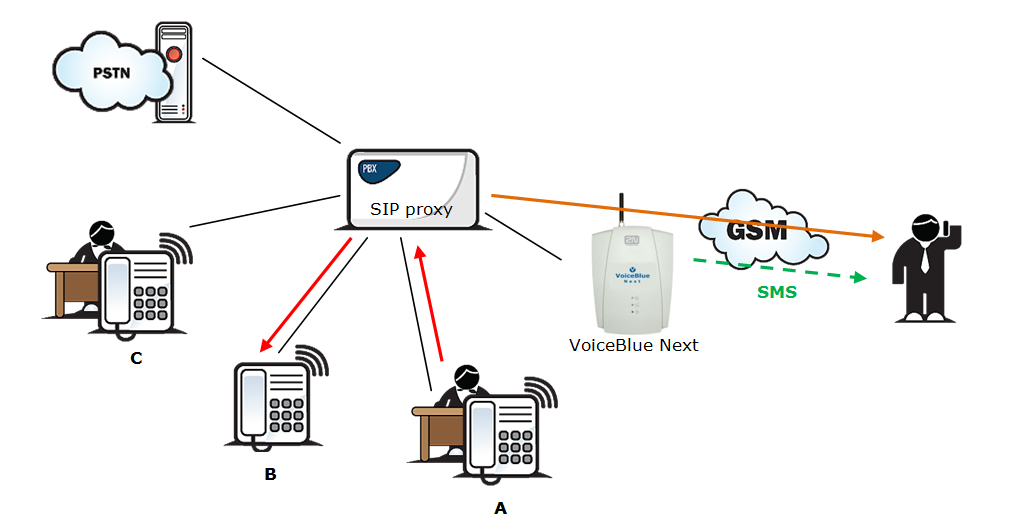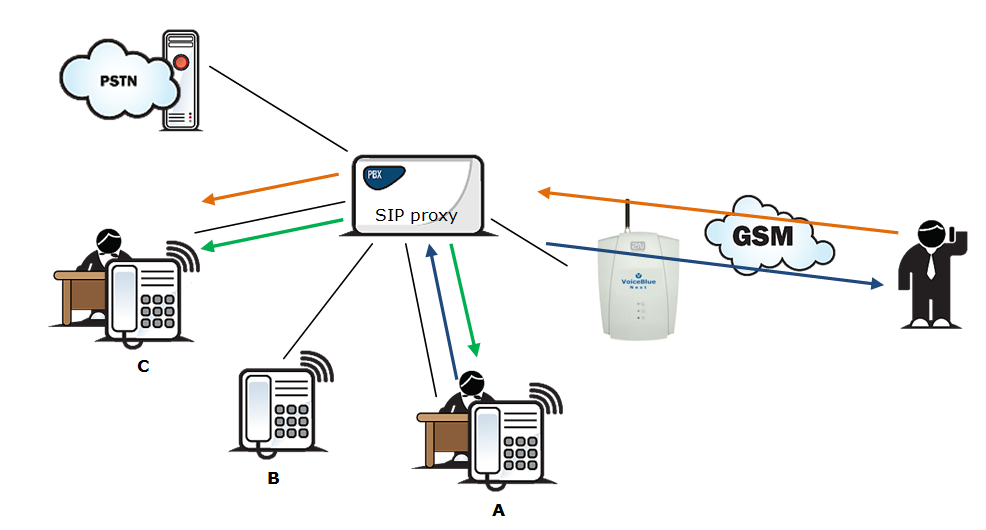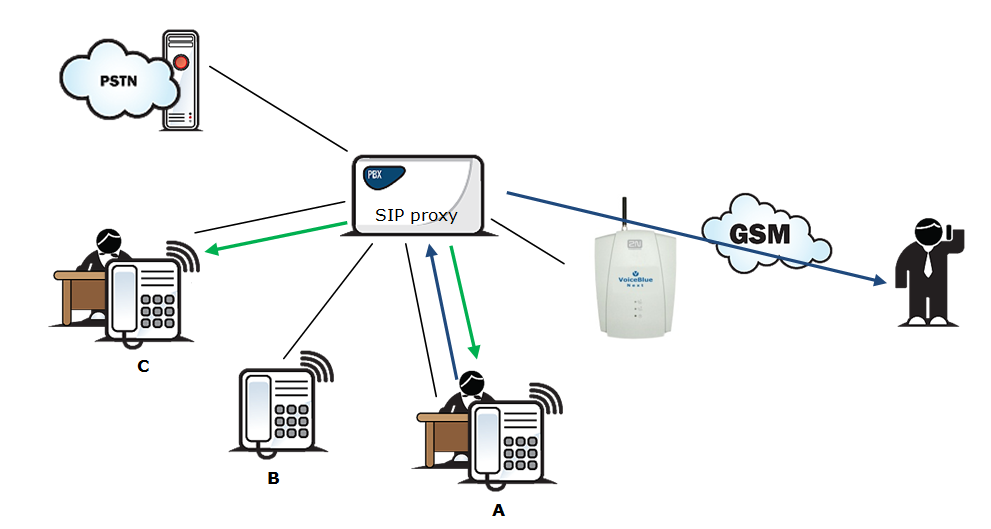3.3 Call Routing
Calls from a VoIP port to a GSM/UMTS network are routed to any GSM/UMTS port according to the LCR (Least Cost Routing) table. If an incoming call is routed via a busy port, other ports are checked automatically for availability (depending on the configuration) and in case no allowed outgoing port is available, the outgoing call is rejected.
The LCR algorithm identifies the outgoing call type, current time tariff rate, day in a week, and/or free minutes of GSM providers and routes outgoing calls accordingly.
Incoming calls from GSM networks are routed directly to the defined SIP address, or the DISA function is activated. Furthermore, calls can be routed according to the CLIP (caller's telephone number). And the CallBack service is also available.
2N® Mobility Extension
2N® Mobility Extension (ME) is a function that turns your mobile phone into an SIP phone taking advantage of all the PBX functions. To make your 2N® Mobility Extension work efficiently, use the 2N® VoiceBlue Next gateway to assign your mobile phone an account with the same SIP parameters (ID/user/password) that help connect your office SIP phone to the SIP Proxy server. After this account gets registered with the SIP Proxy server via 2N® VoiceBlue Next, your mobile phone will work as 2N® Mobility Extension and make use of the services described below.
Advantages:
- You never miss any important call as you are available at all times.
- You can get information SMS messages on missed calls.
- You can control your company PBX call forwarding services from your mobile phone.
- You can make use of a comfortable DTMF code control.
- You need not make complicated forwarding actions as the function is fully automatic.
- ME can work with any SIP Proxy PBX.
- ME can replace any standard VoIP phone.
- Calls to your mobile phone are free of charge or at a moderate cost4.
You need not integrate a costly DECT system any longer.
Model Situation
“Follow me” function
Figure 1: Follow Me Function
Fig. 1 shows routing of calls in the case of absence of a subscriber in the VoIP network. Subscriber A calls subscriber B, for whom the 2N® Mobility Extension function has been permitted with the active “Follow me” function. Subscriber B does not answer the call in the VoIP network and so the call is rerouted to its mobile telephone.
“SMS at no answer” function
In the case of a missed call in the VoIP network, the 2N® Mobility Extension provides sending of an information text announcement. This function is called “SMS at no answer”. Like with call forwarding, it is possible to use the DTMF option to activate and deactivate the service of sending text announcements for missed calls.
Fig. 2 shows sending of information texts if an incoming call is not answered. Subscriber A calls subscriber B, for whom the 2N® Mobility Extension has been permitted with activated “Follow me” and “SMS at no answer” services. Subscriber B does not answer the call in the VoIP network and so the call is rerouted to its mobile telephone. Subscriber B does not answer the mobile phone call and is sent a text announcing that the call from subscriber A has been missed.
"Call forwarding" function
In addition to rerouting calls in the event of absence, the 2N® Mobility Extension allows calls to be forwarded within a VoIP network, which brings the services of the SIP Proxy to a mobile telephone. The description of this function is shown in Fig. 3.
Figure 3: Call Forwarding Function
In Fig. 3 subscriber A is talking to subscriber B, for whom the 2N® Mobility Extension has been permitted. Subscriber A would like to be forwarded to subscriber C. For this reason, subscriber B holds the call with A (7* in the default setting ), dials the number of subscriber C, terminates dialling with the dialling end character (# in the default setting), notifies subscriber C of the call to be forwarded and hangs up to forward the call. If subscriber C does not want to talk to subscriber A, subscriber B terminates the call with C (9# in the default setting) and returns to the call with A.
"Quick call forwarding" function
In Fig. 4 subscriber A is talking to subscriber B, for whom the 2N® Mobility Extension has been permitted. Subscriber A would like to be forwarded to subscriber C. Subscriber B wants to forward the call without having to talk to subscriber C. So subscriber B puts the call with A on hold (7* in the default setting), dials the quick forwarding character (default value #) and dials the telephone number of subscriber C, terminating the dialling with the dialling end character (default value #). Having received the dialling end character, 2N® VoiceBlue Next terminates the call between A and B and attempts to make a call between subscribers A and C. Subscriber A then receives the ring tone.
Figure 4: Quick Call Forward Function
Correct ME configuration:
- Connect the GSM gateway to your PBX/SIP Proxy.
- Check whether the 2N® Mobility Extension licence key has been entered correctly.
- Enter all ME users in the Gateway configuration / Mobility Extension menu.
- Enter the prefix matching the ME user mobile number in the Gateway configuration / prefixes menu.
LCR Table
The LCR (Least Cost Routing) table is the key telephone cost cutting tool. It helps you select call routes according to the called subscriber’s number, daytime and weekdays. By adding bank holidays (with routing rules as on Sundays) to the LCR table you achieve even higher call cost savings.
To make your prefix and LCR routing work properly, enter the prefix of the number to be called to the GSM/UMTS network into the Table of accepted prefixes in the Gateway configuration / Prefixes menu. The number to be called may not exceed the Default count of digits or the higher priority Count of digits setting in the Table of accepted prefixes. The table is searched from top to bottom starting with the first match.
Apply the Table of replaced prefixes to modify the number to be called to the GSM/UMTS network. Every modification is displayed in the "prefix"/"replace with" format (99/+420, e.g.). The Table of replaced prefixes must always contain one record at least or the "/" record if no prefix modification is made. The digits removed from/added to the number in the Table of replaced prefixes are not included in the Count of digits. The table is searched from top to bottom starting with the first match.
GSM network ID is an optional parameter, which is assigned to each LCR record to make the LCR search more convenient. If this parameter is not completed, the list number is only used for identification (1–8).
Poznámka
- Count of digits defines the minimum count of digits to be dialled. Hence, a call is successful if the count of the called number digits is equal to or higher than the value set in the Count of digits.
- The Count of digits does not include the digits removed from/added to the number in the Table of replaced prefixes.
- The Count of digits set in the Table of accepted prefixes has a higher priority than the Default count of digits.
- The Table of replaced prefixes must always contain one record at least or the "/" record if no prefix modification is made.
Make sure that the apriopriate provider's SIM card is inserted in the GSM gateway. Assign the incoming and outgoing groups in the Gateway configuration / GSM groups assignment menu.
For a call setup, the LCR table is searched sequentially from top to bottom. Each LCR table row is assigned a Prefixlist in which the prefix match is searched for. If a match is found, the call will be routed according to the routing group parameters (Groups in the LCR table) as set in the Gateway configuration / GSM outgoing groups table. The call will be connected via the GSM module as assigned to the GSM outgoing groups in the GSM groups assignment table.
If the selected GSM/UMTS module is busy, the call is routed according to the next routing rule included in the Groups and defined by the GSM outgoing groups table. Again, the GSM outgoing group is assigned to a GSM module in the GSM groups assignment table.
The LCR row is checked in this way until a free GSM/UMTS module is found. If no available GSM/UMTS module (GSM outgoing groups) is found, the call is rejected.
Routing Algorithm for Outgoing Calls
The GSM/UMTS outgoing call routing algorithm is launched whenever the SIP Proxy routes an outgoing call to 2N® VoiceBlue Next. Outgoing calls are routed via 2N® VoiceBlue Next as follows:
- The calling subscriber dials the subscriber number and the SIP Proxy routes it to 2N® VoiceBlue Next depending on the SIP Proxy settings.
- The number prefix is checked against the prefixes in the List of networks tables in the ascending sequence, i.e. table 1 is searched first, followed by table 2 and so on.
- When a matching prefix is found in a List of networks, the LCR is checked for a valid row. Again, the LCR is searched upwardly, starting from the first row.
- If a List of networks number matches a valid number on the respective row, the call time is checked against the routing rule. If no match is found, the next LCR row is checked.
- If the List of networks number and call time meet the routing rules, the call is routed to the module selected in the Assignment to GSM groups table according to the first routing rule included in the Groups section and given in the GSM outgoing groups table.
- Moreover, call duration limiting timer can be selected for the outgoing call.
- If the selected GSM/UMTS module is occupied or has a low credit, the algorithm returns to the preceding step but considers the next Groups row instead of the first one. If no record is found in this section, the next LCR row is used.
- If the selected GSM/UMTS module is available and has a sufficient credit, the GSM gateway will start dialling the GSM number.
- If the calling subscriber number has an unknown prefix or all routes are occupied, 2N® VoiceBlue Next rejects the connection request.
- The outgoing call is not billed until the called party answers the call.
- The GSM network signals the call answering moment and the GSM gateway transfers this information to the SIP Proxy.
- It can be set for GSM outgoing calls that the calling subscriber should be sent the connection tone* instead of a silence between the request sending to GSM and the ringing tone.
* This option can be activated for TC35i, MC55i(i-w) modules.
Routing Algorithm for Incoming Calls
Incoming calls are processed according to the Mode parameter setting in the GSM incoming groups table. The following options are available:
- Reject/ Ignore incoming calls – incoming calls are not routed to the VoIP network. On the GSM side, the connection request is either rejected or ignored (the caller hears the check ringing tone).
- If the above mentioned option is not selected, the CLIP routing table is checked. If the calling number is found, it is checked for CallBack first. If the CallBack function is enabled for this number, 2N® VoiceBlue Next will ignore the incoming call and set up a CallBack to GSM after the caller hangs up. If the AutoDial function is enabled for the calling number, the caller will be routed directly to the extension number entered in the AutoDial item. If both the CallBack and AutoDial functions are activated, 2N® VoiceBlue Next will ignore the incoming call and set up a call to GSM after the caller hangs up. Simultaneously, a call to the VoIP extension will be set up and then the calls will be connected. If the CallBack function is enabled and the caller fails to hang up within 10 s, 2N® VoiceBlue Next will try to set up a call according to the AutoDial settings.
- In case the CLIP routing function is disabled or the calling number is not included in the CLIP routing table, the Dynamic CLIP routing table is checked. If the calling number is found, the incoming call is routed directly to the corresponding extension. To set the Dynamic CLIP routing function use the GSM incoming groups menu.
- If the incoming call is still not processed, the gateway will receive the call and send either a voice message or the dialtone to the caller. After that, 2N® VoiceBlue Next awaits the required count of digits necessary for connection set-up. Set the minimum and maximum counts of DTMF digits in the GSM incoming groups menu.
- If 2N® VoiceBlue Next does not receive the minimum count of digits and no other digit comes within the timeout set in the DTMF dialling timeout parameter, the call is forwarded to the operator as if the called extension number were unknown.
- If call forwarding to the operator is inactive, the incoming call will be rejected.
DISA Welcome Note
If the DISA service is active and a welcome note has been recorded, the welcome note is played to every incoming call whose number is not included in the CLIP table or forwarded according to the Dynamic CLIP routing table. When the welcome note has been played, the gateway waits for the first DTMF digit for the period set in the GSM incoming groups / DTMF dialling timeout table. Having received the count of digits included in the GSM incoming groups / Minimum count of DTMF digits table, the gateway will set up connection to the SIP Proxy. Use the GSM gateway web interface to upload the DISA welcome note.




